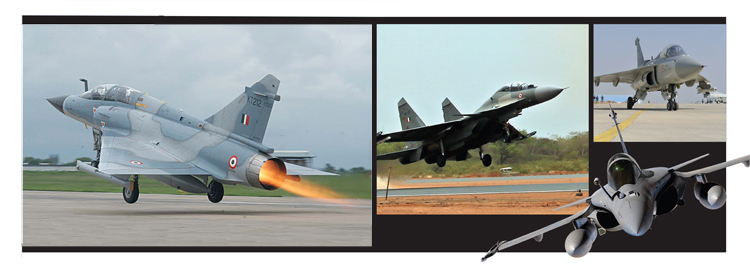The Road Ahead
 AVM Manmohan Bahadur (retd)
AVM Manmohan Bahadur (retd)
The 1965 War’s 50th year commemoration this year brought the present generation face to face with the Indian military of yore, consolidating after the 1962 war debacle and building a reputation to measure up to the expectations of the countrymen.
Much has been written about whether or not the Indian Air Force (IAF) came to the assistance of its army in 1965 (it did), but what is for sure is that the IAF came of age in that 22 day conflict. It was deeply involved in carrying the fight to the enemy, and with the diminutive Gnat getting the better of the superior F-86 Sabre, the IAF had a mascot around which its professional reputation started getting built.
The indigenous aircraft industry also started looking up with the entry into Squadron service of the HF-24 Marut twin engine fighter bomber while the induction of the Su-27 ground attack aircraft and improved versions of MiG-21 saw the IAF augmenting its firepower substantially.

The An-12, a formidable airlifter of those years, was inducted in the transport fleet and with the Mi-8s coming in to the rotary wing fleet to buttress the vertical lift being provided by Mi-4s, the combat support capability got a boost. The culmination of this build-up was seen in the decisive victory in the 1971 war, symbolised by the strategic effects of the Tangail drop by the transport fleet, the Meghna crossing using IAF helicopters and of the MiG-21 strike on the Governor’s House in Dhaka on 14 December 1971 that hastened the capitulation of East Pakistan and the birth of Bangladesh.
1971 was a long way back and much has happened in the intervening four and a half decades. For sure, the golden jubilee commemoration of the 1971 victory would be an event to look forward to, but it is only right that we take stock of the present capabilities of the IAF and crystal gaze into the next two decades, given the security environment that it would have to operate in.
Security Environment
The security environment that India would have to face in the coming decades would be complex. Our sphere of interest has expanded over the past two decades, as would be apparent from the annual reports of the ministry of defence (MoD) over the years. In 2002-03 the annual report defined India’s area of strategic interest as “…from the Persian Gulf in the west to the Straits of Malacca in the east and from the Central Asian Republics in the north to near the equator in the south...” This underwent an expansion over the years and the 2012-13 report stated that “India’s size and strategic location… links its security environment with the extended neighbourhood particularly with neighbouring countries and the regions of West, Central Asia, South East Asia, East Asia and the Indian Ocean.”
The 2014-15 MoD report has not been specific in terms of geographical area but has left it as, “India’s geo-strategic location makes it sensitive to developments beyond its immediate neighbourhood, in West Asia, Central Asia, in the Indian Ocean Region and the Asia Pacific region. Major geopolitical and geo-economic developments are currently transforming the global security scenario into one of uncertainty and volatility.”
more
This permits the political and diplomatic decision-maker to be flexible in his approach but for the military planner such ambiguity expands the horizon where contingencies have to be planned for. The IAF leadership, thus, has a plateful to cater to, with fleets whose major combatants are approaching obsolescence, a defence budget that is not likely to go beyond the 1.8 per cent (or 2 per cent maximum) GDP mark and an indigenous defence industry that has yet to take off. The 83rd anniversary of the IAF approaches on October 8 with myriad challenges for the air arm of the nation, especially for its fighter fleet.
Fighter Fleet
The Sukhoi-30 is the mainstay of the strike fleet of the IAF. With an order of 272 fighters, the air dominance Su-30 would be the instrument to carry the war to the adversary. The Su 30 entered service in 1999 and held sway for the first decade of this century with its Beyond Visual Range (BVR) air to air missile capability. With its air to air refueling ability, the range of the Su 30 is indeed something to talk about and its 12 hard points enable a substantial load to be delivered at the adversary; for weapon carriage, the aircraft truly packs a punch. The unique thrust vectoring enables the Sukhoi to manoeuvre aggressively in aerial combat while its two man crew prevents pilot overload and enhances situational awareness in the cockpit. There are maintenance issues plaguing the Sukhoi, especially engine related problems (a fact accepted by the defence minister in Parliament), and one hopes that the modification carried out proves successful. Incidentally, the initial reports are encouraging.
The enigmatic Rafale has lived up to its name, which in French means a gust of wind! Now that the government has decided that only 36 would be purchased, it is worth considering whether two Squadrons worth buy would suffice to augment the depleting fighter force. The figure is sufficient to give the government a five year breather during which it can make up its mind to either induct more Rafales or go in for a cheaper single engine fighter, as has been speculated in the media. If it comes to the latter, then the LCA Mk2 would have to prove its paces in the intervening period, otherwise Saab is waiting in the wings with its Gripen offer. Either ways, the indecision has not been good for force planning, which is not to say that the IAF’s deterrence posture has come down. The Rafale carries a very potent weapons suite and is eagerly looked forward-to by the IAF for its Active Electronically Scanned Array radar, 14 hard points (including some which can carry drop tanks for extended range), modern electronic warfare suite for survivability and its BVR air to air and air to round weapons, especially the Meteor missile.
The MiG 21/27 fleets still have a few years to go but are certainly on their way out. The MiG-29 upgrade is underway at the IAF Base Repair Depot at Nasik and it will substantially improve the firepower and flight range of the aircraft on internal f
Subscribe To Force
Fuel Fearless Journalism with Your Yearly Subscription
SUBSCRIBE NOW
We don’t tell you how to do your job…
But we put the environment in which you do your job in perspective, so that when you step out you do so with the complete picture.








